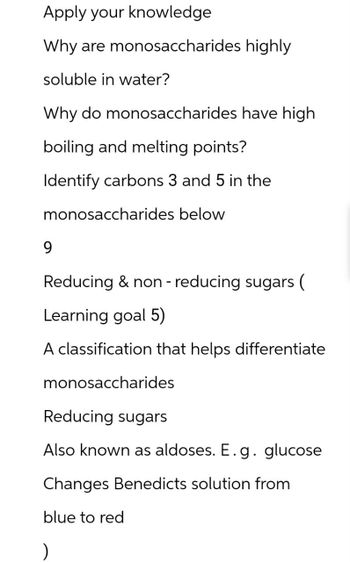
Anatomy & Physiology
1st Edition
ISBN: 9781938168130
Author: Kelly A. Young, James A. Wise, Peter DeSaix, Dean H. Kruse, Brandon Poe, Eddie Johnson, Jody E. Johnson, Oksana Korol, J. Gordon Betts, Mark Womble
Publisher: OpenStax College
expand_more
expand_more
format_list_bulleted
Question

Transcribed Image Text:Apply your knowledge
Why are monosaccharides highly
soluble in water?
Why do monosaccharides have high
boiling and melting points?
Identify carbons 3 and 5 in the
monosaccharides below
9
Reducing & non - reducing sugars (
Learning goal 5)
A classification that helps differentiate
monosaccharides
Reducing sugars
Also known as aldoses. E. g. glucose
Changes Benedicts solution from
)
blue to red
Expert Solution
This question has been solved!
Explore an expertly crafted, step-by-step solution for a thorough understanding of key concepts.
Step by stepSolved in 2 steps

Knowledge Booster
Similar questions
- VISUALIZE The structures depicted are (a) enantiomers (b) different views of the same molecule (c) geometric (cistrans) isomers (d) both geometric isomers and enantiomers (e) structural isomersarrow_forwardLactose is a disaccharide formed by the formation of a bond between glucose and glycosidic; lactose glycosidic; galactose hydrogen; sucrose hydrogen; fructosearrow_forwardSaturated fats have all of the following characteristics except: they are solid at room temperature they have single bonds within the carbon chain they are usually obtained from animal sources they tend to dissolve in water easilyarrow_forward
- In 1976, a team of chemists in the United Kingdom was developing new insecticides by modifying sugars with chlorine (Cl2), phosgene (Cl2CO), and other toxic gases. One young member of the team misunderstood his verbal instructions to test a new molecule. He thought he had been told to taste it. Luckily for him, the molecule was not toxic, but it was very sweet. It became the food additive sucralose. Sucralose has three chlorine atoms substituted for three hydroxyl groups of sucrose (table sugar): The altered sugar binds so strongly to the sweet-taste receptors on the tongue that the human brain perceives it as 600 times sweeter than sucrose. Sucralose was originally marketed as an artificial sweetener called Splenda, but it is now available under several other brand names. Researchers investigated whether the body recognizes sucralose as a carbohydrate by feeding sucralose labeled with 14C to volunteers. Analysis of the radioactive molecules in the volunteers urine and feces showed that 92.8 percent of the sucralose passed through the body without being altered. Some people are worried that the chlorine atoms impart toxicity to sucralose. How would you respond to that concern?arrow_forwardCellulose and starch are examples of: monosaccharides disaccharides lipids polysaccharidesarrow_forwardFigure 3.5 What kind of sugars are these, aldose or ketose?arrow_forward
- Name three kinds of carbohydrates that can be built using only glucose monomers.arrow_forwardC6H12O6 is the chemical formula for a ________. polymer of carbohydrate pentose monosaccharide hexose monosaccharide all of the abovearrow_forwardSaturated fatty acids are so named because they are saturated with (a) hydrogen (b) water (c) hydroxyl groups (d) glycerol (e) double bondsarrow_forward
- Match the terms with their most suitable description. ____ hydrophilic a. protons electrons ____ atomic number b. number of protons in nucleus ____ hydrogen bonds c. polar; dissolves easily in water ____ positive charge d. collectively strong ____ negative charge e. protons electrons ____ temperature f. measure of molecular motion ____ pH g. water-dreading ____ covalent bond h. electron sharing ____ hydrophobic i. reflects H+ concentrationarrow_forwardA monosaccharide is formed from a polysaccharide in what kind of reaction? oxidation-reduction reaction anabolic reaction catabolic reaction biosynthetic reactionarrow_forwardFatty acids in phospholipids and triacylglycerols interact with one another by (a) disulfide bridges (b) van der Waals interactions (c) covalent bonds (d) hydrogen bonds (e) fatty acids do not interact with one anotherarrow_forward
arrow_back_ios
SEE MORE QUESTIONS
arrow_forward_ios
Recommended textbooks for you
 Anatomy & PhysiologyBiologyISBN:9781938168130Author:Kelly A. Young, James A. Wise, Peter DeSaix, Dean H. Kruse, Brandon Poe, Eddie Johnson, Jody E. Johnson, Oksana Korol, J. Gordon Betts, Mark WomblePublisher:OpenStax College
Anatomy & PhysiologyBiologyISBN:9781938168130Author:Kelly A. Young, James A. Wise, Peter DeSaix, Dean H. Kruse, Brandon Poe, Eddie Johnson, Jody E. Johnson, Oksana Korol, J. Gordon Betts, Mark WomblePublisher:OpenStax College Biology: The Unity and Diversity of Life (MindTap...BiologyISBN:9781305073951Author:Cecie Starr, Ralph Taggart, Christine Evers, Lisa StarrPublisher:Cengage Learning
Biology: The Unity and Diversity of Life (MindTap...BiologyISBN:9781305073951Author:Cecie Starr, Ralph Taggart, Christine Evers, Lisa StarrPublisher:Cengage Learning Biology (MindTap Course List)BiologyISBN:9781337392938Author:Eldra Solomon, Charles Martin, Diana W. Martin, Linda R. BergPublisher:Cengage Learning
Biology (MindTap Course List)BiologyISBN:9781337392938Author:Eldra Solomon, Charles Martin, Diana W. Martin, Linda R. BergPublisher:Cengage Learning Biology 2eBiologyISBN:9781947172517Author:Matthew Douglas, Jung Choi, Mary Ann ClarkPublisher:OpenStax
Biology 2eBiologyISBN:9781947172517Author:Matthew Douglas, Jung Choi, Mary Ann ClarkPublisher:OpenStax Biology: The Unity and Diversity of Life (MindTap...BiologyISBN:9781337408332Author:Cecie Starr, Ralph Taggart, Christine Evers, Lisa StarrPublisher:Cengage Learning
Biology: The Unity and Diversity of Life (MindTap...BiologyISBN:9781337408332Author:Cecie Starr, Ralph Taggart, Christine Evers, Lisa StarrPublisher:Cengage Learning Biology Today and Tomorrow without Physiology (Mi...BiologyISBN:9781305117396Author:Cecie Starr, Christine Evers, Lisa StarrPublisher:Cengage Learning
Biology Today and Tomorrow without Physiology (Mi...BiologyISBN:9781305117396Author:Cecie Starr, Christine Evers, Lisa StarrPublisher:Cengage Learning

Anatomy & Physiology
Biology
ISBN:9781938168130
Author:Kelly A. Young, James A. Wise, Peter DeSaix, Dean H. Kruse, Brandon Poe, Eddie Johnson, Jody E. Johnson, Oksana Korol, J. Gordon Betts, Mark Womble
Publisher:OpenStax College

Biology: The Unity and Diversity of Life (MindTap...
Biology
ISBN:9781305073951
Author:Cecie Starr, Ralph Taggart, Christine Evers, Lisa Starr
Publisher:Cengage Learning

Biology (MindTap Course List)
Biology
ISBN:9781337392938
Author:Eldra Solomon, Charles Martin, Diana W. Martin, Linda R. Berg
Publisher:Cengage Learning

Biology 2e
Biology
ISBN:9781947172517
Author:Matthew Douglas, Jung Choi, Mary Ann Clark
Publisher:OpenStax

Biology: The Unity and Diversity of Life (MindTap...
Biology
ISBN:9781337408332
Author:Cecie Starr, Ralph Taggart, Christine Evers, Lisa Starr
Publisher:Cengage Learning

Biology Today and Tomorrow without Physiology (Mi...
Biology
ISBN:9781305117396
Author:Cecie Starr, Christine Evers, Lisa Starr
Publisher:Cengage Learning